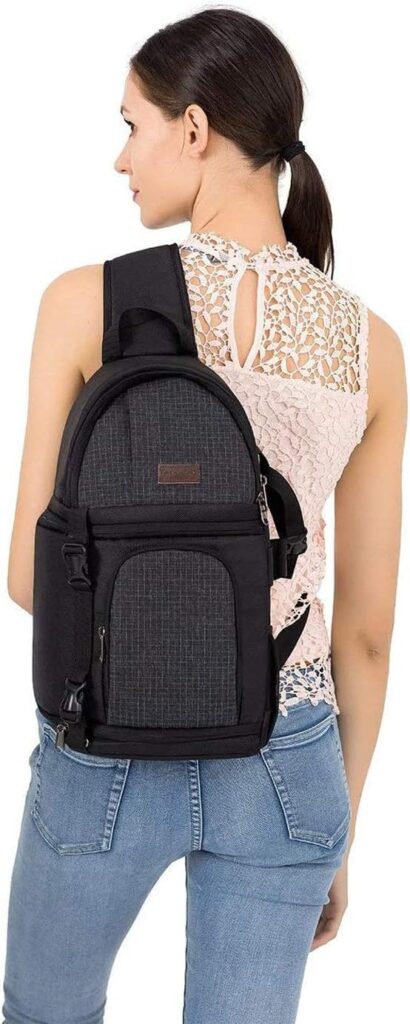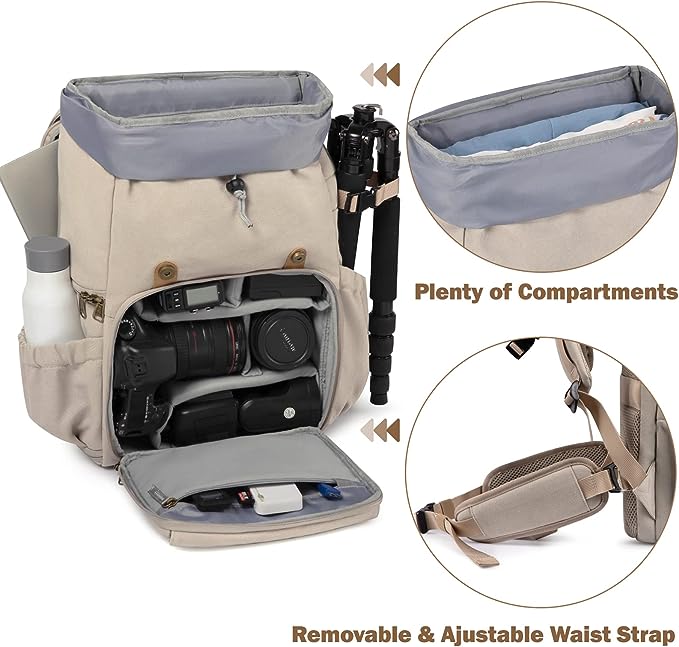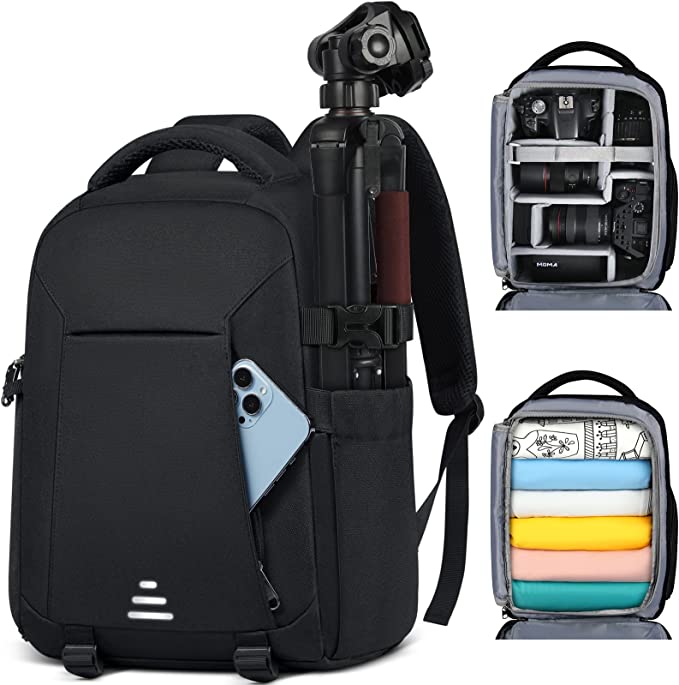Elevate your photography expeditions with a specialized travel camera bag designed to keep your gear secure and your adventures seamless.
The correct travel camera backpack may have a big influence on how you experience and share your adventure, regardless of whether you’re a seasoned traveler who takes pictures throughout the world or a casual enthusiast who enjoys documenting local beauties.
However, picking the best travel camera bag is not an easy matter.
We’ll look into the numerous camera bag varieties that are offered, each one designed to suit a certain travel style and photography choice.
The possibilities are as varied as the places you’d like to travel, from roomy backpacks made to hold large gear sets to svelte shoulder bags ideal for city exploration.
You may choose a backpack that complements your particular photographic style and travel preferences by taking note of its achievements and failures.
Remember, you need some travel essentials in your backpack, like the best travel jumpsuit and casual beach outfits, as well as your travel slippers.
The Importance of a suitable travel camera bag
A good travel camera bag may have a significant influence on the caliber of your trip photography experience and is more than simply a place to store your camera equipment. Having the correct camera bag becomes crucial when you travel to new places and try to capture the spirit of local cultures, landscapes, and moments for a number of compelling reasons.
Protection of Precious Equipment
A good travel camera bag provides the padding, pockets, and reinforcement required to protect your gear from the inevitable jolts, bumps, and bad weather encountered while traveling.
Organized Accessibility
Travel chaos may be exhausting, and searching through a disorganized backpack for a particular lens or accessory can be time-consuming and irritating. Intelligently placed dividers and pockets in a travel camera bag keep your equipment properly organized. You can immediately find what you need thanks to specialized storage areas for various products, which lets you record fleeting moments without losing a beat. You can concentrate on your creative process rather than fumbling with your equipment, thanks to this controlled accessibility.
Flexibility for changing scenarios
Your photographic demands might range greatly, from busy metropolitan streets to quiet natural vistas. An appropriate travel camera bag adjusts to these shifts by offering adaptable storage options that support various gear setups. Whether you’re taking expansive landscape photos, close-up portraits, or quick action pictures, your camera bag should unwaveringly support your creative decisions.
Comfort during long journeys
Long journeys, strenuous excursions, or even protracted waiting times are sometimes required when exploring new places. Long-term use of heavy camera equipment may wear out your body and sap your enthusiasm. To equally distribute the weight and reduce strain, the ideal travel camera bag combines ergonomic elements like cushioned straps and back support.
Preserving Creative Momentum
Inspiration may strike at any time, and no photographer wants to miss the ideal image because it would be difficult to get to their camera. With quick and simple access to your equipment provided by a good travel camera bag, you can take advantage of opportunities as they present themselves. Your camera bag should enable you to capture the spirit of the moment without restriction, whether it’s a fleeting emotion on a subject’s face or a breathtaking sunset.
Confidence in Traveling Light
Carrying large, heavy camera bags might make it difficult to move around and restrict your ability to discover. The requirements for utility and compactness are both taken into account while designing a travel camera bag. The ideal bag enables you to travel light while still having all the necessary equipment for outstanding photography by effectively organizing your gear and providing a streamlined style.
The best camera bag guarantees that your equipment is prepared to capture each spectacular moment as it presents itself, whether you’re a professional photographer recording tales for customers or an amateur enthusiast chronicling your personal journeys.
Camera Backpack

Key Features to Consider in a Travel Camera Bag
Protection and Padding
The security it provides for your priceless photography gear should be a top consideration for any travel camera bag. Choose a bag that will protect your cameras and lenses from shocks and vibrations by having well-padded sections, separators, and shock-resistant materials. Your equipment will stay dry and secure amid unforeseen weather changes with the help of an additional layer of weatherproofing.
Accessibility and Quick-Draw Options
It might be the difference between catching a brief moment and missing it totally to be able to quickly access your camera. Choose a bag with side pockets and different access points, such as front-loading compartments. You may recover your camera using these quick-draw alternatives without having to take the entire backpack off.
Customization and flexibility
Look for a travel camera bag that features movable inserts and partitions that can be customized. With the use of these capabilities, you may alter the internal design to suit different camera bodies, lenses, and accessories. Due to its adaptability, your backpack will meet your shifting photography demands.
Comfort and ergonomics
Long-term carrying of photography gear can be physically taxing, especially when you’re out on a trek or a lengthy stroll. Pick a bag with a well-designed weight distribution and cushioned shoulder and back straps. You may explore and take pictures while feeling at ease thanks to ergonomic features that avoid pain and tiredness.
Size and capacity
The quantity of gear you want to carry should match the size of the bag. Take into account both your present equipment and any upcoming additions. You may carry your things without feeling overburdened if there is a balance between enough capacity and an acceptable size.
Laptop and Tablet Compartment
For editing and sharing their work while on the road, many photographers bring computers or iPads. Electronic gadgets are shielded from camera gear by a special container that also adds further security for your computer gear.
Security Features
To protect pricey stuff like memory cards, batteries, or personal items, look for a bag with locking zippers or even concealed compartments.
Weight
You may carry your stuff comfortably and within luggage allowances if it is in a light bag that offers enough protection.
Price and Value
There are several pricing points for high-quality travel camera bags. Budgetary concerns are crucial but don’t forget that a high-quality bag will last longer and provide superior protection in the long term.
Camera Sling Bag

Types of Travel Camera Bags
Backpacks
Travel camera backpacks are adaptable and well-liked options for photographers who carry a lot of equipment. For camera bodies, several lenses, accessories, and even personal stuff, they offer plenty of room. Both shoulders are equally loaded, which makes them comfortable for prolonged travel or excursions. Many types come with movable dividers that allow you to change the internal design and provide quick access to your goods in multiple sections.
Shoulder Bags
Urban photography and rapid access are built into shoulder purses. They include a single shoulder strap and can hold a camera body with a connected lens, a few extra lenses, and necessary items like batteries and memory cards. They might not, however, provide as much room for substantial gear installations.
Sling Bags
Sling bags blend the comfort of backpacks with the ease of shoulder bags. They may be swiftly moved to the front for simple access while being worn diagonally across the torso. They are ideal for day trips and other circumstances when you need to be able to move about freely because they frequently feature many pockets for personal things and photographic equipment.
Rolling Camera Bags
Similar to carry-on luggage, rolling camera cases include wheels and a retractable handle. For photographers who fly and want to make sure their equipment is well protected during transport, they are excellent. They might not be as practical, though, if there are steps or uneven ground present.
Waist packs and belt systems
Fanny packs and belt systems are other names for waist packs, which are small and allow you to carry a small quantity of goods around your waist. For photographers who want to travel light or participate in activities where having both hands free is essential, they’re perfect. For short trips and situations when you need to have your goods close at hand, waist packs are a good option.
Messenger Bags
Camera equipment may be carried in a comfortable and fashionable way using messenger bags. They typically include a single cross-body strap with compartments for personal stuff, cameras, and lenses. Although messenger bags may not be as accommodating for heavier gear setups, they are appropriate for informal trips and city travel.
Hard Cases and Inserts
Hard cases and cushioned inserts, which are not conventional bags, may make ordinary bags or baggage into camera-friendly travel accessories. Particularly for flights, hard bags offer good protection, and cushioned inserts let you arrange your belongings in whichever style you choose.
Each sort of travel camera bag has advantages and disadvantages of its own.
Camera Backpack


Tips for Packing Your Travel Camera Bag
When you pack your travel camera bag carefully, you can make sure that your camera gear is both well-protected and convenient to access when those picture-perfect moments happen. To assist you in maximizing your packing technique, consider the following advice:
Prioritize essential gear
Determine the important photographic equipment you’ll need before the trip. Usually, this consists of your camera body, a versatile lens, extra batteries, memory cards, and any other equipment essential to your particular photographic style.
Use protective lens cases
Spend money on protective lens covers or bags to safeguard individual lenses within your camera bag from nicks and accidents.
Arrange cameras and lenses strategically
Put your camera body and most-used lens in the container that is easiest to reach. This makes it possible for you to swiftly grab your camera for unplanned photos.
Consider weather protection
In case of unforeseen rain or other bad weather, bring weather-resistant coverings for your camera and lens.
Separate clean and used items
To prevent mixing up old and clean batteries and memory cards when traveling, use different pouches or bags for each.
Consider personal items
For personal goods like a water bottle, food, or a small notebook, some camera backpacks have pockets.
Balance the weight
To avoid fatigue when carrying the bag for a lengthy amount of time, distribute the weight of your equipment equally inside the bag.
Label and organize cables
To stop cords from tangling, use cable organizers or Velcro ties and identify each one with a name for easy recognition.

Future Trends in Travel Camera Bags
Future-looking trends that promise to completely transform how we transport and safeguard our priceless photographic equipment are as follows:
Smart Connectivity and Integration
Future camera bags might have smart features like Bluetooth or Wi-Fi connectivity, enabling you to remotely manage your camera’s settings or immediately transfer photographs from your bag to a linked device.
Wireless charging and power solutions
You could soon be able to charge your smartphone, camera batteries, and other items just within your luggage thanks to integrated wireless charging capabilities.
Adaptive and shape-shifting designs
Innovative building materials and design ideas may result in camera bags that change in size and form according to the arrangement of your equipment. When carrying limited equipment, this might maximize storage capacity and save bulk, or it may enlarge to hold more gear.
Environmental Sustainability
The emphasis on sustainability will probably become more prominent in camera bags in the future. With the rising concern for environmental preservation, eco-friendly components, production methods, and materials may become standard.
Biometric Security Features
The security of your expensive equipment might be improved by biometric security features like fingerprint or facial recognition locks that guarantee that only authorized people can access it.

Maintaining and Cleaning Your Travel Camera Bag
Your vacation camera bag will last longer if it is regularly maintained and cleaned, and it will also keep your photographic equipment in great shape.
Routine Cleaning
Shake Out Debris: Gently shake the bag to remove any dust or other loose materials that may have been collected within.
Use a tiny handheld vacuum cleaner or an air blower to clear the inside pockets and compartments of dust and debris.
Cleaning the exterior
Moist Cloth: To remove dirt and smudges from bags with fabric exteriors, use a soft, moist cloth.
Always do a spot test initially at a discrete location.
Use a leather conditioner to keep the leather supple and avoid cracking if your bag includes leather embellishments.
Interior Cleaning
Take caution not to harm any electronics or fragile materials.
Surface Cleaning: To remove dirt and grime from surfaces in fabric interiors, use a slightly moist cloth. To prevent harming your equipment, make sure the towel is not very damp.
Organizing Your Gear
Compartments should be checked to make sure that all dividers and modular inserts are in the proper places. This disables gear changes while driving.
Lens Caps and Smaller Accessories: To prevent them from becoming misplaced, keep lens caps and other small accessories in designated pockets or compartments.
Maintaining Zippers and Straps
Lubricate Zippers: Zippers may stiffen with time. To keep your zippers from sticking, lightly lubricate them.
Examine Straps: Regularly look for any indications of wear, fraying, or weakening in the straps and buckles. If necessary, swap them out to keep your backpack safe and comfortable to carry.

Conclusion
Your travel camera bag becomes more than simply a piece of luggage when you go off on adventures full of fascinating people, breathtaking scenery, and priceless moments; it becomes a vital ally in your artistic aspirations.
It is a well-organized refuge that guarantees easy access to your camera and accessories, so you can easily record ephemeral moments.
Understanding your shooting demands, embracing advances, and striking the proper balance between usefulness and design are all steps in the process of choosing the ideal travel camera bag.
Your backpack may develop into more than just a means of transportation; it might develop into a hub of connectedness, intellect, and productivity that ably supports your creative process.
What are your thoughts about a travel camera bag?
Why book with Viator.com? Do more with Viator
For Top Destinations! Top Attractions! Top Tours. Just get the best out of Viator today.

Ivisa.com helps you find Visa information for all countries. Simplifying Travel Around The World and also offers Online Travel Visa Checks.

I recommend Booking.com because is a great place for hotel bookings with No Booking Fees. Low Rates. Best Price Guarantee.

Trip.com is another good website where you can make your flight bookings with Low-cost flights and easy booking with Instant confirmation.

We could receive a little commission. if you purchase after clicking one of our links. This helps us to maintain the website, and we sincerely appreciate it.
